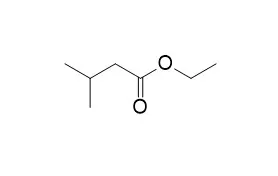| Structure Identification: |
| 2000, 80(11):1659-1667. | | Quantitative determination of the odorants of young red wines from different grape varieties.[Reference: WebLink] |
METHODS AND RESULTS:
Fifty-two young monovarietal red wines made with Grenache (17 samples), Tempranillo (11 samples), Cabernet Sauvignon (12 samples) and Merlot (12 samples) grapes have been analysed by HRGC–MS to obtain quantitative data on 47 odorants previously identified as potential aroma contributors by olfactometric techniques. Thirty-three odorants were present in the wines at concentrations higher than their corresponding odour thresholds. These include ethyl octanoate, β-damascenone, ethyl hexanoate, isovaleric acid and isoamyl acetate as the most important, which together with isoamyl and β-phenylethyl alcohols, fatty acids, 2,3-butanedione and ethyl butyrate are always found at concentrations higher than their odour thresholds. In some cases the ethyl esters of isobutyric and isovaleric acids, β-ionone, methionol, isobutyric acid, ethyl cinnamate, ethyl dihydrocinnamate, γ-nonalactone, eugenol, c-3-hexanol, geraniol, guaiacol, 3-isobutyl-2-methoxypyrazine, 4-ethylguaiacol, acetoin and t-whiskylactone were at a concentration high enough to be odour-active.
CONCLUSIONS:
There were 30 compounds that were found to differ significantly between varieties. These include 3-isobutyl-2-methoxypyrazine, isoamyl acetate, isovaleric acid, ethyl isobutyrate, Ethyl isovalerate, fusel alcohols, c-3-hexenol, methionol, eugenol, guaiacol and γ-nonalactone. |
|






 Cell. 2018 Jan 11;172(1-2):249-261.e12. doi: 10.1016/j.cell.2017.12.019.IF=36.216(2019)
Cell. 2018 Jan 11;172(1-2):249-261.e12. doi: 10.1016/j.cell.2017.12.019.IF=36.216(2019) Cell Metab. 2020 Mar 3;31(3):534-548.e5. doi: 10.1016/j.cmet.2020.01.002.IF=22.415(2019)
Cell Metab. 2020 Mar 3;31(3):534-548.e5. doi: 10.1016/j.cmet.2020.01.002.IF=22.415(2019) Mol Cell. 2017 Nov 16;68(4):673-685.e6. doi: 10.1016/j.molcel.2017.10.022.IF=14.548(2019)
Mol Cell. 2017 Nov 16;68(4):673-685.e6. doi: 10.1016/j.molcel.2017.10.022.IF=14.548(2019)